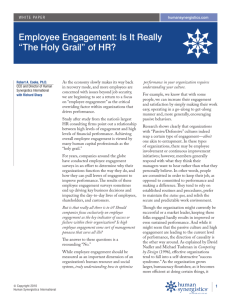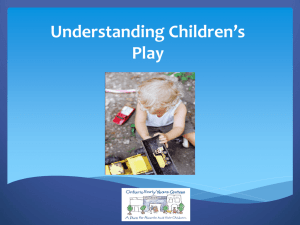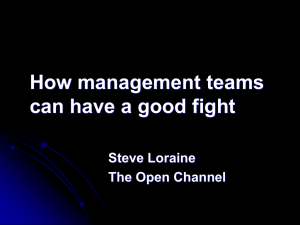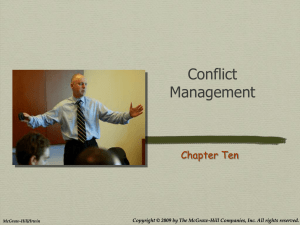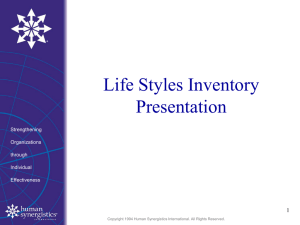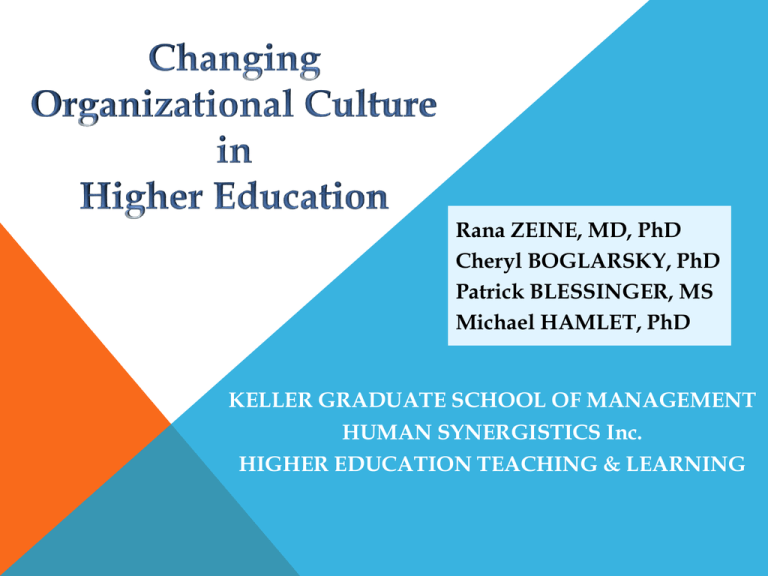
Rana ZEINE, MD, PhD
Cheryl BOGLARSKY, PhD
Patrick BLESSINGER, MS
Michael HAMLET, PhD
KELLER GRADUATE SCHOOL OF MANAGEMENT
HUMAN SYNERGISTICS Inc.
HIGHER EDUCATION TEACHING & LEARNING
12 CULTURAL STYLES
CONSTRUCTIVE
•Achievement
•Self-Actualizing
•Humanistic – Encouraging
•Affiliative
DEFENSIVE
PASSIVE
•Approval
•Conventional
•Dependent
•Avoidance
AGGRESSIVE
•Oppositional
•Power
•Competitive
•Perfectionistic
From Organizational Culture Inventory
by Robert A. Cooke and J. Clayton Lafferty, 1987,
Plymouth, MI: Human Synergistics International.
Copyright © 1987, 2011 by Human Synergistics, Inc.
ORGANIZATIONAL CULTURE INVENTORY®
CIRCUMPLEX
SATISFACTION NEEDS
T
A
S
K
O
R
I
E
N
T
E
D
Research & Development
by Cooke & Lafferty,
Copyright © 1973-2011 by
Human Synergistics
International.
All rights reserved.
P
E
O
P
L
E
SECURITY NEEDS
O
R
I
E
N
T
E
D
OCI measures
(1) BEHAVIORAL NORMS
members understand are
EXPECTED of them to “FIT
IN” and meet expectations
in their current position at
their organization
(2) OUTCOMES: Individual,
Group & Organizational
OCI-IDEAL
“DESIRED state”
cultural benchmark:
asks members to indicate
the extent to which
behavioral norms SHOULD
(in their opinion) be expected
in order to maximize their
organization’s effectiveness
CONSTRUCTIVE STYLES
Constructive Cultures encourage members to
• interact with people and
• approach tasks
in ways that will help them to meet their
higher-order satisfaction needs for
• affiliation,
• esteem and
• self-actualization
Encourage communication, cooperation,
flexibility, consultation, coordination
ACHIEVEMENT CULTURE 11:00
• Do things well
• Value members who set and accomplish
their own goals.
• Members are expected to set challenging but
realistic goals, establish plans to reach these
goals, and pursue them with enthusiasm.
(Pursue a standard of excellence;
Openly show enthusiasm)
• Effective organizations
• Problems are solved appropriately
• Clients and customers are served well,
• Healthy orientation
SELF-ACTUALIZATION CULTURE 12:00
• Value creativity and quality over quantity
• Value both task accomplishment and
individual growth
• Members are encouraged to gain enjoyment
from their work, develop themselves, and
take on new and interesting activities.
(Think in unique and independent ways;
Do even simple tasks well)
• Innovative organizations
• Offer high-quality products and/or services,
• Attract and develop outstanding employees
HUMANISTIC-ENCOURAGING CULTURE
1:00
• Managed in a participative way
• Person-centered
• Members are expected to be supportive,
constructive and open to influence in their
dealings with one another.
(Help others to grow and develop;
Take time with people)
• Effective organizational performance
• Providing for the growth and active
involvement of members
• High satisfaction and commitment of members
AFFILIATIVE CULTURE 2:00
• Place a high priority on constructive
interpersonal relationships
• Members are expected to be friendly, open, and
sensitive to the satisfaction of their work group.
(Deal with others in a friendly, pleasant way;
Share feelings and thoughts)
• Enhance organizational performance
• Promoting open communication, good
cooperation, and the effective coordination of
activities.
• Members are loyal to their work groups and
feel they “fit in” comfortably.
PASSIVE / DEFENSIVE STYLES
Passive/Defensive Cultures are those in which
members believe they must
•
interact with people in ways that will not
threaten their own security
•
conflicts are primarily resolved by either
accommodation or withdrawal
•
consequences include unresolved conflicts,
de-motivation, work avoidance and high
turnover
APPROVAL CULTURE 3:00
• Conflicts are avoided
• Interpersonal relationships are pleasant – at
least superficially
• Members feel that they should
agree with others (Go along with others)
gain the approval of others
be liked by others (Be liked by everyone)
• Can limit organizational effectiveness
• Minimize constructive “differing”
• Inhibit the expression of ideas and opinions
CONVENTIONAL CULTURE 4:00
Conservative, Traditional
Bureaucratically controlled
Members are expected to conform
Follow the rules
Make a good impression
(Always follow policies;
Fit into the “mold”)
• Can interfere with effectiveness
• Suppressing innovation
• Preventing the organization from adapting
to changes in its environment
•
•
•
•
•
DEPENDENT CULTURE 5:00
Hierarchically controlled
Non-participative
Do not empower their members
Centralized decision making
Members do only what they are told
Clear all decisions with superiors
(Please those in positions of authority;
Do what is expected)
• Poor performance
• Lack of individual initiative, spontaneity,
flexibility, and timely decision making
•
•
•
•
•
•
AVOIDANCE CULTURE 6:00
Fail to reward success
Punish mistakes
Negative reward system
Members shift responsibilities to others
Avoid any possibility of being blamed for a
mistake
(Wait for others to act first;
Take few chances)
• Survival of the organization is in question
• Members are unwilling to make decisions,
take action, or accept risks
•
•
•
•
•
AGGRESSIVE / DEFENSIVE STYLES
Aggressive/Defensive Cultures expect members to
•
approach tasks in forceful ways to protect their
status and security
•
value confrontation, criticism, coercion and
overconfidence
•
consequences include insecurity,
disempowerment, disrespect, and punishment
OPPOSITIONAL CULTURE 7:00
• Confrontation prevails
• Negativism is rewarded
• Members gain status and influence by
being critical
• Reinforced to oppose the ideas of others
(Point out flaws;
Be hard to impress)
• Make safe (but ineffectual) decisions
• Can lead to unnecessary conflict, poor
group problem solving and “watereddown” solutions to problems
POWER CULTURE 8:00
• Non-participative
• Organization structured on the basis of the
authority inherent in members’ positions
• Members believe they will be rewarded for
taking charge and controlling subordinates
• Responsive to the demands of superiors
(Build up one’s power base;
Demand loyalty)
• Power-oriented
• Less effective than members think
• Subordinates resist control, hold back
information, and reduce their contributions
to the minimal acceptable level.
COMPETITIVE CULTURE 9:00
• Winning is valued
• Members are rewarded for out-performing
one another
• Members operate in a “win-lose” framework
• Believe they must work against (rather than
with) their peers to be noticed
(Turn the job into a contest;
Never appear to lose)
• Can inhibit effectiveness by reducing
cooperation and promoting unrealistic
standards of performance that are either too
high or too low.
PERFECTIONISTIC CULTURE 10:00
• Perfectionism, persistence, and hard
work are valued
• Members feel they must avoid any
mistakes, keep track of everything,
and work long hours to attain
narrowly-defined objectives
(Do things perfectly;
Keep on top of everything)
• Can lead members to lose sight of the
goal, get lost in detail, and develop
symptoms of strain
• Military
• Nuclear Plant
• Emergency Medical
• “life and death”
nature of operations
Constructive norms are desired and important for success
because they help people to understand the reasons why
orders need to be followed, and the benefits of faithfully
implementing best practices in performing critical duties.
OCI® RESULTS
CURRENT CULTURE
N=63
IDEAL CULTURE
N=33
Research & Development by Cooke & Lafferty, Copyright © 1973-2011 by Human Synergistics International. All rights reserved.
Zeine, Boglarsky, Blessinger & Hamlet (2011). Ch.3 In Kazeroony (Ed.), The
Strategic Management of Higher Education Institutions: Serving Students as
Customers for Institutional Growth. Business Expert Press, Williston, VT.
Organization Level
Faculty/Professor
Director
Department Chair
Associate. Dean
Dean
Provost/Dean AA
nd*
OCI Ideal
40%
45%
24%
12%
6%
6%
6%
6%
11%
9%
2%
3%
11%
18%
Education
Bachelor’s degree
Master’s degree
Doctorate degree
MD
MD/PhD
Other
nd*
OCI Ideal
2%
3%
21%
15%
52%
58%
2%
3%
19%
18%
2%
3%
3%
Yrs @ Organization
Less than 6 mo
6 months to 1 yr
1 to 2 years
2 to 4 years
4 to 6 years
6 to 10 years
10 to 15 years
More than 15 yrs
nd*
OCI Ideal
5%
6%
3%
0%
16%
18%
17%
24%
6%
9%
13%
18%
13%
9%
22%
15%
5%
-
Institutional Type
For-profit, Public
For- profit, Private
Not-for-profit,
Public
Not-for-profit,
Private
nd*
OCI Ideal
17%
12%
21%
24%
38%
33%
16%
8%
18%
12%
Zeine et al. 2011
GAP ANALYSIS FOR CULTURE STYLES IN HEds
STYLE
PERCENTILE SCORE
IDEAL
CURRENT GAP
CLUSTER
HUMANISTIC-ENCOURAGING
98
73
-25
CONSTRUCTIVE
ACHIEVEMENT
98
67
-31
CONSTRUCTIVE
SELF-ACTUALIZING
98
61
-37
CONSTRUCTIVE
AFFILIATIVE
92
55
-37
CONSTRUCTIVE
OPPOSITIONAL
57
67
10
AGGRESSIVE/DEFENSIVE
COMPETITIVE
31
63
32
AGGRESSIVE/DEFENSIVE
PERFECTIONISTIC
23
52
29
AGGRESSIVE/DEFENSIVE
POWER
23
50
27
AGGRESSIVE/DEFENSIVE
AVOIDANCE
15
59
44
PASSIVE/DEFENSIVE
DEPENDENT
14
55
41
PASSIVE/DEFENSIVE
CONVENTIONAL
10
54
44
PASSIVE/DEFENSIVE
ORGANIZATIONAL OUTCOMES
Individual Outcomes
Motivation, Performance, Satisfaction, Stress
Group Outcomes
Teamwork, Inter-Unit Coordination,
Unit-level Quality
Organizational Outcomes
Organizational-level Quality
Customer Service Quality
External Adaptibility
Cooke, 1987
SUBCULTURES CURRENT
IDEAL OCI®
NON-PROFIT
N=34
N=17
FOR-PROFIT
N=24
N=12
SUBCULTURES in HIGHER EDUCATION
ACADEMIC STAFF
Differentiation
• Different Priorities & Interests
Individualism
• Independence, Autonomy,
Individual Goals
Fragmentation
• Lack of Interaction &
Understanding
Interaction
• Collegiality, Interpersonal
Dynamics
ADMINISTRATORS
• Different Stakeholders &
Work Styles
• ‘ I ’ Emphasis & Anarchy
• Bureaucracies & Skepticism
• Professionalism & Open
Dialogue
Interviews (n=18) about Perceptions
(1) Professional, (2) Differential, (3) Fragmentary RELATIONSHIPS
Kuo, 2009. J. Higher Education Policy & Management. 31(1):43-54
Perceptions of Academics and
Students as Customers: a Survey of
Administrative Staff in Higher Education.
Pitman, T. (2000).
Journal of Higher Education Policy and Management, 22(2), 165-175.
Halbesleben, J.R.B., Becker, J.A.H. and Buckley, M.R. (2003).
Considering the Labor Contributions of Students:
An Alternative to the Student-as-Customer
Metaphor. Journal of Education for Business, May-June, pp. 255-257.
Obermiller, C., Fleenor, P. and Raven, P. (2005).
Students as Customers or Products:
Perceptions and Preferences of Faculty
and Students. Marketing Education Review, 15(2), 27-36.
Customers: Identifying the Needs
in Higher Education. Educational Research, 1(7), 210-218.
Akinyele, S.T. (2010).
LEADING CHANGE
1) Use belief systems (vision, mission, core values) and
performance measures to strike an effective balance
between creativity and control. Become living
symbols of the newly minted organizational culture
and assist executives to fulfill this requirement by
providing training and appropriate feedback systems.
2) Plan for, create and celebrate progress and work
accomplishments.
3) Enlist people: highly talented, intelligent, energetic,
tenacious, committed to placing the interests of the
organization above their own self-interests.
4) Empower change enthusiasts with communication and
consultation skills.
5) Establish effective conflict resolution processes.
6) Convey a sense of urgency by increasing awareness of
the need for change.
LEADING CHANGE
7) Identify, replace or eliminate rules and policies (i.e.
compensation, performance-appraisal systems,
organizational priorities) that are incompatible with the
new vision. Implement open-door policy.
8) Ensure inclusive involvement and participation in
shaping the transformative process.
9) Build trust by disseminating information to people in all
roles and at all levels throughout the organization.
10) Inspire imagination and creativity by safeguarding
freedoms, encouraging risk-taking and protecting
research time.
11) Search constantly for newer and better ways.
12) Developing a shared vision and ensuring congruency
of action.
13) Supporting one another, working together, encourage
open-mindedness, innovation, problem-solving.
Seven Practices of High Performing Organizations
1) Employment security, or employment opportunity
alternatives (externships, internships, work-study,
career development and placement services)
2) Selective hiring, or selective admission alternatives
3) Self-managed teams and decentralization of decision
making, or participative cultural alternatives
(feedback, communication, consultation)
4) Comparatively high compensation contingent on
organizational performance, or academic support
alternatives (grants, fellowships, scholarships)
5) Extensive training including leadership, management
and communication skills
6) Reduced status distinctions and barriers
7) Extensive sharing of financial and performance
information throughout the organization
Pfeffer (1998). In The Human Equation: Building Profits by Putting People First Boston, MA Harvard Business School Press.
CULTIVATING CONSTRUCTIVE CULTURES
1) Ensure that all members are given the opportunity to
work to their full potential
2) Balance expectations for taking initiative and thinking
independently with those for consensus, power sharing
3) Expect participation without domination
4) Elicit unique perspectives and concerns while working
towards agreement
5) Value quality over quantity
6) Value creativity over conformity
7) Judge effectiveness at the system level rather than the
component level
8) Practice empowerment and transformational
leadership which are prescriptive (guide and direct)
rather than restrictive (constrain and prohibit) practices
CULTIVATING CONSTRUCTIVE CULTURES
9) Adopt approaches for continuous, system-wide,
improvements including problem solving, strategic
planning, innovation, and benchmarking
10) Inspire innovation by allowing people to express
themselves, experiment and learn from mistakes
11) Increase accomplishments by encouraging people to
set challenging goals, and by providing them with
necessary resources
12) Cultivate mentors by investing in training and
development, and by providing opportunities for
expansion
13) Enhance cooperation by letting people communicate,
get to know one another, contribute, share ideas
14) Inculcate humanistic values of mutual
encouragement and support
CULTIVATING CONSTRUCTIVE CULTURES
15) Develop organizational mechanisms to collect and
respond to feedback, implement good suggestions
16) Remember that education institutions are “Learning
Organizations” which emphasize creativity,
individual development and systems thinking
17) Treat all members of the organization with respect
and dignity
18) Provide equitable pathways for advancement (or
alternative opportunities for placement elsewhere)
Zeine et al. 2011

